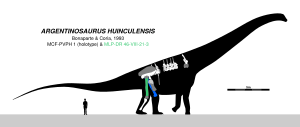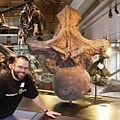Argentinosaurus facts for kids
Quick facts for kids Argentinosaurus |
|
|---|---|
 |
|
| Reconstructed skeleton, Museo Municipal Carmen Funes, Plaza Huincul, Argentina. The original vertebrae are seen on the lower left | |
| Scientific classification |
|
| Kingdom: | Animalia |
| Phylum: | Chordata |
| Clade: | Dinosauria |
| Clade: | Saurischia |
| Suborder: | †Sauropodomorpha |
| Clade: | †Sauropoda |
| Clade: | †Titanosauria |
| Clade: | †Lithostrotia |
| Clade: | †Lognkosauria |
| Genus: | †Argentinosaurus Bonaparte & Coria, 1993 |
| Type species | |
| †Argentinosaurus huinculensis Bonaparte & Coria, 1993
|
|
Argentinosaurus was a giant plant-eating dinosaur that lived in what is now Argentina, South America, during the Cretaceous period. It was a type of titanosaurid sauropod, which means it had a very long neck and tail, walked on four legs, and ate only plants.
Argentinosaurus means "Argentina lizard." It was named by paleontologists Rodolfo Coria and José Bonaparte in 1993. Scientists found its fossils, including parts of its backbones, a leg bone (tibia), ribs, and hip bones (sacrum), in Neuquén Province, Argentina.
Many people think Argentinosaurus might have been the largest dinosaur ever! However, it's hard to be completely sure because we only have a few of its bones. Because of this, paleontologists often use other, more complete dinosaur skeletons, like Saltasaurus or Dreadnoughtus, to make their size calculations.
How Big Was Argentinosaurus?
Since we don't have a full skeleton of Argentinosaurus, scientists have different ideas about its exact size. Here are some of the estimates:
- Thomas Holtz thought it might have been around 120 feet (36.6 meters) long.
- Mickey Mortimer estimated it to be between 22 and 26 meters long.
These different estimates show how tricky it is to know the exact size of a dinosaur when only a few bones have been found.
Images for kids
-
A cast of a dorsal vertebra (backbone) from Argentinosaurus, seen from the left side. This is at the Natural History Museum of Los Angeles County.
-
A reconstruction of the Argentinosaurus skeleton, seen from above, at the Fernbank Museum of Natural History.
See also
 In Spanish: Argentinosaurus huinculensis para niños
In Spanish: Argentinosaurus huinculensis para niños








